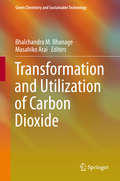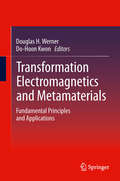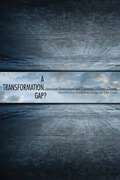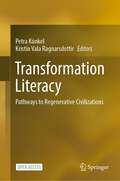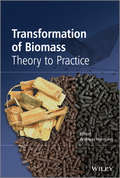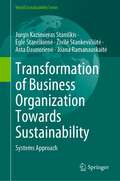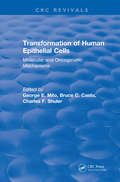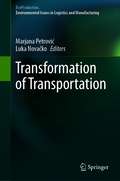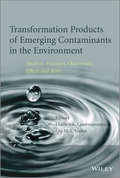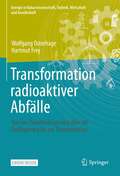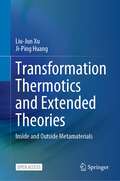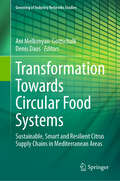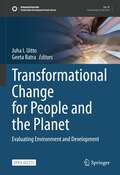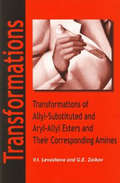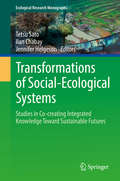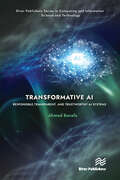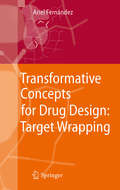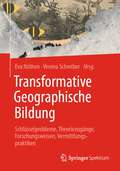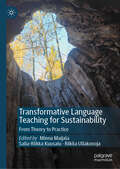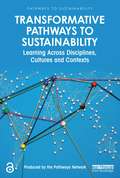- Table View
- List View
Transformation and Utilization of Carbon Dioxide
by Bhalchandra M. Bhanage Masahiko AraiTransformation and Utilization of Carbon Dioxide shows the various organic, polymeric and inorganic compounds which result from the transformation of carbon dioxide through chemical, photocatalytic, electrochemical, inorganic and biological processes. The book consists of twelve chapters demonstrating interesting examples of these reactions, depending on the types of reaction and catalyst. It also includes two chapters dealing with the utilization of carbon dioxide as a reaction promoter and presents a wide range of examples of chemistry and chemical engineering with carbon dioxide. Transformation and Utilization of Carbon Dioxide is a collective work of reviews illustrative of recent advances in the transformation and utilization of carbon dioxide. This book is interesting and useful to a wide readership in the various fields of chemical science and engineering. Bhalchandra Bhanage is a professor of industrial and engineering chemistry at Institute of Chemical Technology, India. Masahiko Arai is a professor of chemical engineering at Hokkaido University, Japan.
Transformation Electromagnetics and Metamaterials: Fundamental Principles and Applications
by Do-Hoon Kwon Douglas H. WernerTransformation electromagnetics is a systematic design technique for optical and electromagnetic devices that enables novel wave-material interaction properties. The associated metamaterials technology for designing and realizing optical and electromagnetic devices can control the behavior of light and electromagnetic waves in ways that have not been conventionally possible. The technique is credited with numerous novel device designs, most notably the invisibility cloaks, perfect lenses and a host of other remarkable devices. Transformation Electromagnetics and Metamaterials: Fundamental Principles and Applications presents a comprehensive treatment of the rapidly growing area of transformation electromagnetics and related metamaterial technology with contributions on the subject provided by a collection of leading experts from around the world. On the theoretical side, the following questions will be addressed: "Where does transformation electromagnetics come from?," "What are the general material properties for different classes of coordinate transformations?," "What are the limitations and challenges of device realizations?," and "What theoretical tools are available to make the coordinate transformation-based designs more amenable to fabrication using currently available techniques?" The comprehensive theoretical treatment will be complemented by device designs and/or realizations in various frequency regimes and applications including acoustic, radio frequency, terahertz, infrared, and the visible spectrum. The applications encompass invisibility cloaks, gradient-index lenses in the microwave and optical regimes, negative-index superlenses for sub-wavelength resolution focusing, flat lenses that produce highly collimated beams from an embedded antenna or optical source, beam concentrators, polarization rotators and splitters, perfect electromagnetic absorbers, and many others. This book will serve as the authoritative reference for students and researchers alike to the fast-evolving and exciting research area of transformation electromagnetics/optics, its application to the design of revolutionary new devices, and their associated metamaterial realizations.
A Transformation Gap?
by Theo Farrell Terriff Terry Osinga FransThis study, edited by Terriff (American security policy, U. of Calgary, Canada), Osinga (war studies, Royal Netherlands Military Academy) and Farrell (war studies, King's College London, UK), examines the extent to which there are gaps in the military transformation being led by the United States between various European members of the North Atlantic Treaty Organization. Case studies are presented for Britain, France, Germany, Spain, the Netherlands, and Poland. The case studies follow a common analytical framework that breaks transformation down into network-enablement, effects based operations, and expeditionary warfare and, for each of these, in terms of their respective technological, doctrinal, and organizational elements. These elements are further considered in light of the scholarly literature on military innovation, norm diffusion, and alliance theory. Stanford Security Studies is an imprint of Stanford University Press. Annotation ©2011 Book News, Inc. , Portland, OR (booknews. com)
Transformation Literacy: Pathways to Regenerative Civilizations
by Petra Künkel Kristin Vala RagnarsdottirThis open access book brings science and practice together and inspires a global movement towards co-creating regenerative civilizations that work for 100% of humanity and the Earth as a whole. With its conceptual foundation of the concept of transformation literacy it enhances the knowledge and capacity of decision-makers, change agents and institutional actors to steward transformations effectively across institutions, societal sectors and nations.Humanity is at crossroads. Resource depletion and exponential emissions that not only cause climate change, but endanger the health of people and planet, call for a decisive turnaround of human civilization. A new and transformative paradigm is emerging that advocates for regenerative civilizations, in which a narrative of systemic health as much as individual and collective vitality guide the interaction of socio-economic-ecological systems. Truly transformative change must go far beyond technical solutions, and instead envision what can be termed ‘a new operating system’ that helps humankind to live well within the planetary boundaries and partner with life’s evolutionary processes. This requires transformations at three different levels:· Mindsets that reconnect with a worldview in which human agency acknowledges its co-evolutionary pathways with each other and the Earth.· Political, social and economic systems that are regenerative and foster the care-taking for Earth life support systems.· Competencies to design and implement effective large-scale transformative change processes at multiple levels with multiple stakeholders.This book provides key ingredients for enhancing transformation literacy from various perspectives around the globe. It connects the emerging practice of stewarding transformative change across business, government institutions and civil society actors with the most promising scientific models and concepts that underpin human action to shape the future collectively in accordance with planetary needs.
Transformation of Biomass
by Andreas HornungBiomass is a key resource for meeting the energy and material demands of mankind in the future. As a result, businesses and technologies are developing around biomass processing and its applications. Transformation of Biomass: Theory to Practice explores the modern applications of biomass and bio-based residues for the generation of energy, heat and chemical products. The first chapter presents readers with a broad overview of biomass and its composition, conversion routes and products. The following chapters deal with specific technologies, including anaerobic digestion, pyrolysis and gasification, as well as hydrothermal and supercritical conversion. Each chapter details current practises, recent developments, business case models and comprehensive analysis of the problems associated with each approach, and how to optimize them. Topics covered include: Anaerobic digestion Reactor design Pyrolysis Catalysis in biomass transformation Engines for combined heat and power Influence of feedstocks on performance and products Bio-hydrogen from biomass Analysis of bio-oils Numerical simulation and formal kinetic parameters evaluation Business case development This textbook will provide students, researchers and industry professionals with a practical and accessible guide to the essential skills required to advance in the field of bioenergy.
Transformation of Business Organization Towards Sustainability: Systems Approach (World Sustainability Series)
by Asta Daunorienė Jurgis Kazimieras Staniškis Eglė Staniškienė Živilė Stankevičiūtė Joana RamanauskaitėWe have entered a new era where business, technologies, communities, and even pandemic deceases cross borders with unprecedented speed and intensity. 2030 Agenda and 17 SDGs reflect the global community's high expectations of finally reversing the destruction of our natural and social habits, and achieving a more balanced and equitable pathways toward well-being of all. However, despite the initial efforts, the world is not on track to achieving the most of the 169 targets that comprise the goals. It is evident that we have a system problem, so we need a system solution. Authors presented a hierarchical system consisting of two-level management systems: first level—unsustainability reduction systems and second level—control system for transformations toward sustainability. The book clearly shows that implementation of systems for unsustainability reduction and for transformations toward sustainability is possible, and that sufficient knowledge is available to get started. It is designed for researchers, practitioners, and politicians.
Transformation of Human Epithelial Cells: Molecular and Oncogenetic Mechanisms (CRC Press Revivals)
by George E Milo Bruce C Casto Charles F ShulerThis book offers a conceptual explanation of the interrelationships that exist between the stages in the progression of initiated epithelial cells in culture compared with the diverse tissue of organs and the progression of tumors from different organ sites. The fate of the modification of adducts is discussed at the molecular level. The role that modifications in hot spots in oncogenes and supressor genes play at the molecular level and how these molecular modifications can lead to an explanation of molecular control in the formation of tumor phenotypes is also examined. Researchers in cell biology and toxicology, applied pharmacology, carcinogenesis, teratogenesis, mutagenesis, and molecular toxicology will find the book useful, interesting reading.
The Transformation of Italian Armed Forces in Comparative Perspective: Adapt, Improvise, Overcome? (Military Strategy and Operational Art)
by Fabrizio Coticchia Francesco N. MoroEuropean armed forces have undergone deep changes in the past two decades. Given the breadth of the debate and the size of transformations that took place, it is somewhat surprising that relatively few academic studies have directly dealt with changes in force structure of European militaries, and the Italian armed forces in particular. The focus of this book is the organizational dimension of the restructuring of armed forces through 3 different lenses: doctrine and strategic framework, budget and resource allocation, and force structure and deployment. The key issues addressed relate to how these factors interact in shaping transformation. Of particular interest is the theme of learning, which is how armed forces endogenize change in the short and long run. This study provides valuable insights into the extent to which armed forces manage to adapt to the emerging strategic and operational challenges they have to face and to illustrate the weight of institutional legacies, resource constraints and inter-organizational learning in shaping transformation. Focusing on the Italian case in comparative perspective and based on a large variety of military operations from airstrikes to peacekeeping and counterinsurgency, the book provides an innovative viewpoint on military transformation and significantly contributes to our understanding of contemporary security that is deeply shaped by the lessons learnt in Afghanistan, Lebanon, Iraq and Libya.
Transformation of Transportation (EcoProduction)
by Marjana Petrović Luka NovačkoThis book features original scientific manuscripts submitted for publication at the International Conference – The Science and Development of Transport (ZIRP 2020), organized by University of Zagreb, Faculty of Transport and Traffic Sciences, Zagreb, and held in Šibenik, Croatia, from 29th to 30th September 2020. The conference brought together scientists and practitioners to share innovative solutions available to everyone. Presenting the latest scientific research, case studies and best practices in the fields of transport and logistics, the book covers topics such as sustainable urban mobility and logistics, safety and policy, data science, process automation, and inventory forecasting, improving competitiveness in the transport and logistics services market and increasing customer satisfaction. The book is of interest to experienced researchers and professionals as well as Ph.D. students in the fields of transport and logistics.
Transformation Products of Emerging Contaminants in the Environment
by Dimitra A. Lambropoulou Leo M. NolletOne of the first books to cover transformation products, rather than primary compounds, Transformation Products of Emerging Contaminants in the Environment gathers, specifies, synthesizes, and advances existing knowledge of the most important transformation product (TPs) of the main groups of emerging contaminants with potential concern to human health and the environment. This two-volume set for researchers and professionals covers the sources of TPs of emerging contaminants and their environmental behavior, their occurrence and effects on urban and marine environments, risk assessment and management, and technologies and strategies available for control.
Transformation radioaktiver Abfälle: Von der Zwischenlagerung über die Endlagerung bis zur Transmutation (Energie in Naturwissenschaft, Technik, Wirtschaft und Gesellschaft)
by Wolfgang Osterhage Hartmut FreyDieses Buch gibt einen Überblick über den Umgang mit radioaktiven Reststoffen. Es zeigt auf, welche Quellen für radioaktive Abfälle es gibt, wie die Optionen Zwischenlagerung und Endlagerung gestalte sind, sowie, welche Problem sich aus dem Transport radioaktiver Stoffe ergeben. Schließlich beschreibt es noch die Möglichkeit der Transmutation - also die Elementumwandlung durch gezielte Kernreaktionen - und eine dazugehörige Anwendung.
Transformation radioaktiver Abfälle: Von der Zwischenlagerung über die Endlagerung bis zur Transmutation (Energie in Naturwissenschaft, Technik, Wirtschaft und Gesellschaft)
by Wolfgang Osterhage Hartmut FreyDieses Buch gibt einen Überblick über den Umgang mit radioaktiven Reststoffen. Es zeigt auf, welche Quellen für radioaktive Abfälle es gibt, wie die Optionen Zwischenlagerung und Endlagerung gestalte sind, sowie, welche Problem sich aus dem Transport radioaktiver Stoffe ergeben. Schließlich beschreibt es noch die Möglichkeit der Transmutation - also die Elementumwandlung durch gezielte Kernreaktionen - und eine dazugehörige Anwendung.
Transformation Thermotics and Extended Theories: Inside and Outside Metamaterials
by Liu-Jun Xu Ji-Ping HuangThis open access book describes the theory of transformation thermotics and its extended theories for the active control of macroscopic thermal phenomena of artificial systems, which is in sharp contrast to classical thermodynamics comprising the four thermodynamic laws for the passive description of macroscopic thermal phenomena of natural systems. This monograph consists of two parts, i.e., inside and outside metamaterials, and covers the basic concepts and mathematical methods, which are necessary to understand the thermal problems extensively investigated in physics, but also in other disciplines of engineering and materials. The analyses rely on models solved by analytical techniques accompanied by computer simulations and laboratory experiments. This monograph can not only be a bridge linking three first-class disciplines, i.e., physics, thermophysics, and materials science, but also contribute to interdisciplinary development.
Transformation Towards Circular Food Systems: Sustainable, Smart and Resilient Citrus Supply Chains in Mediterranean Areas (Greening of Industry Networks Studies #13)
by Ani Melkonyan-Gottschalk Denis DausThis book opens up horizons for designing innovative supply chains of citrus by-products, taking into consideration the current socio-economic situation of the actors, citrus production and distribution infrastructure, consumer preferences, and digitization progress at farmer and production levels. Moreover, the book aims to facilitate an interdisciplinary and systemic understanding of the challenges and opportunities within citrus supply chains, promoting collaborative efforts towards a more sustainable future. While sustainability in food supply chains is a global concern, the book specifically concentrates on the unique challenges and opportunities faced in the Mediterranean region. The diverse climatic conditions, cultural nuances, and market dynamics in this region require context-specific solutions, making this focus a valuable aspect of the book, while keeping the link to the global view on food supply chains. The book emphasizes evidence-based practices and encourages readers to implement data-driven approaches to enhance the sustainability, resilience, and circularity of food supply chains. To facilitate the implementation of data-driven solutions, the authors use advanced data analytics methodologies to forecast crop yields accurately (considering local agrometeorological, soil, typology conditions), optimize supply chain processes (traceability of the citrus by-products, enhancement of production processes through technology overhauling), and minimize crop wastage, while opening new markets for citrus by-products. These data-driven solutions empower stakeholders with valuable insights to make informed decisions and achieve operational excellence, meanwhile offering healthy and sustainable nutrition to the consumers. Beyond theoretical discussions, the book offers practical insights and real-world case studies that highlight successful sustainable practices implemented by various stakeholders in the citrus supply chain. These examples serve as inspirations for readers to initiate positive changes within their own organizations, countries, and cities through implementation of interdisciplinary and systemic transformation pathways within food systems.
Transformational Change for People and the Planet: Evaluating Environment and Development (Sustainable Development Goals Series)
by Juha I. Uitto Geeta BatraThis Open Access book deals with the pressing question of how to achieve transformational change that reconciles development with environmental sustainability. It particularly focuses on the role of evaluation in finding sustainable solutions. Environment and development are closely interlinked, as are human health and ecosystem health. The pandemic that began in 2020 demonstrated in no uncertain terms how destruction of habitats has allowed hitherto unknown pathogens spill over to humans wreaking havoc on people’s lives and livelihoods. We are already seeing the impacts of global climate change in terms of heatwaves, forest fires and increased storms. The Sustainable Development Goals (SDGs) explicitly recognize the equal importance of the social, economic and environmental dimensions of development. In these turbulent times, when humankind faces multiple complex challenges it is essential to know that our responses are effective and that they make a positive difference. Evaluation can provide invaluable lessons to how we design policies, strategies and programs and how we allocate limited resources between competing priorities. This book brings together key thinkers and practitioners from the public and private sectors, from major multilateral organizations and from bilateral donor agencies, to present the latest knowledge and experience on how to evaluate interventions in the nexus of environment and development. The book does not promote any particular approach or methodology, but rather emphasizes the need for mixed methods to address the question at hand in the best and most suitable manner. It covers cases from a variety of fields, from climate change mitigation and adaptation, energy efficiency and renewable energy, natural resources management, biodiversity conservation and more.This book is not a conference proceedings although it has its roots in the Third International Conference on Evaluating Environment and Development organized by the GEF Independent Evaluation Office in October 2019. The conference brought together a larger number of established and upcoming evaluators, researchers and evaluation users from the Global North and South, representing a wide variety of organizations, to discuss the frontiers of environment and development evaluation. Following the conference, the editors identified and contacted the participants who made key contributions at the conference and asked them to develop their ideas and papers into book chapters according to a coherent plan.
Transformations in Research, Higher Education and the Academic Market: The Breakdown of Scientific Thought
by Alexandra Waluszewski Sharon Rider Ylva HasselbergThis volume tackles head-on the controversy regarding the tensions between the principles underlying Academe on the one hand, and the free market on the other. Its outspoken thesis posits that seemingly irresistible institutional pressures are betraying a core principle of the Enlightenment: that the free pursuit of knowledge is of the highest value in its own right. As 'market principles' are forced on universities, inducing a neoteric culture of 'managerialism', many worry that the very characteristics that made European higher education in particular such a success are being eroded and replaced by ideological opportunism and economic expediency. Richly interdisciplinary, the anthology explores a wealth of issues such as the phenomenon of bibliometrics (linking an institution's success to the volume and visibility of publications produced). Many argue that the use of such indicators to measure scientific value is inimical to the time-consuming complexities of genuine truth-seeking. A number of the greatest discoveries and innovations in the history of science, such as Newton's laws of mechanics or the Mendelian laws of inheritance, might never have seen the light of day if today's system of determining and defining the form and content of science had dominated. With analytical perspectives from political science, economics, philosophy and media studies, the collection interrogates, for example, the doctrine of graduate employability that exerts such a powerful influence on course type and structure, especially on technical and professional training. In contrast, the liberal arts must choose between adaptation to the dictates of employability strategies or wither away as enrollments dwindle and resources evaporate. Research projects and aims have also become an area of controversy, with many governments now assessing the value of proposals in terms of assumed commercial benefits. The contributors argue that these changes, as well as 'reforms' in the managerial and administrative structures in tertiary education, constitute a radical break with the previous ontology of science and scholarship: a change in its very character, and not merely its form. It shows that the 'scientific thinking' students, researchers, and scholars are encouraged to adopt is undergoing a rapid shift in conceptual content, with significant consequences not only for science, but also for the society of which it is a part.
Transformations of Allyl-Substituted and Aryl-Allyl Esters and Their Corresponding Amines
by Levashova Gennady ZaikovThe book generally shows the interrelation between allyl unit structure of the initial ester and composition and structure of its products. The first part studies the pathways of chemical regrouping in chlorallylaryl and bisarylallyl esters using quantum-chemical calculations. Energy parameters, structural features and electron structure of interme
Transformations of Social-Ecological Systems: Studies in Co-creating Integrated Knowledge Toward Sustainable Futures (Ecological Research Monographs)
by Tetsu Sato Ilan Chabay Jennifer HelgesonThrough this book, readers will gain a comprehensive overview of transdisciplinary knowledge co-production in local contexts as an issue-driven and solution-oriented process, and will come to understand its relationship to societal transformation processes toward sustainability. In a single volume, the theory, approaches and academic implications of this novel type of knowledge production are addressed, together with its societal impacts.In the midst of global anthropogenic impacts that affect various environments, over the past few decades we have observed autonomous initiatives in local communities around the world to tackle these environmental challenges. It is vital that such local actions be scaled up to achieve sustainable societies, which requires societal transformation on larger scales. Thanks to numerous collaborative actions in local communities, transdisciplinary knowledge co-production among diverse stakeholders has successfully been mobilized, resulting in the development of Integrated Local Environmental Knowledge (ILEK); knowledge that can inform and support decisions and actions promoting the sustainable transformation of society. This book uses comparative case studies in communities around the world to illuminate and clarify processes and factors promoting the co-production and utilization of ILEK to facilitate decision-making. In addition, readers will gain deeper insights into the science-society interactions that can contribute to finding collaborative solutions to a wide range of critical environmental problems. Though the book is ideally suited for researchers and students, it also offers a valuable resource for practitioners, government agencies, and stakeholder agencies.
Transformative AI: Responsible, Transparent, and Trustworthy AI systems (River Publishers Series in Computing and Information Science and Technology)
by Ahmed BanafaTransformative Artificial Intelligence provides a comprehensive overview of the latest trends, challenges, applications, and opportunities in the field of Artificial Intelligence. The book covers the state of the art in AI research, including machine learning, natural language processing, computer vision, and robotics, and explores how these technologies are transforming various industries and domains, such as healthcare, finance, education, and entertainment.The book also addresses the challenges that come with the widespread adoption of AI, including ethical concerns, bias, and the impact on jobs and society. It provides insights into how to mitigate these challenges and how to design AI systems that are responsible, transparent, and trustworthy.The book offers a forward-looking perspective on the future of AI, exploring the emerging trends and applications that are likely to shape the next decade of AI innovation. It also provides practical guidance for businesses and individuals on how to leverage the power of AI to create new products, services, and opportunities.Overall, the book is an essential read for anyone who wants to stay ahead of the curve in the rapidly evolving field of Artificial Intelligence and understand the impact that this transformative technology will have on our lives in the coming years.
Transformative Concepts for Drug Design: Target Wrapping
by Ariel FernandezIn spite of the enticing promises of the post-genomic era, the pharmaceutical world is in a state of disarray. Drug discovery seems now riskier and more uncertain than ever. Thus, projects get routinely terminated in mid-stage clinical trials, new targets are getting harder to find, and successful therapeutic agents are often recalled as unanticipated side effects are discovered. Exploiting the huge output of genomic studies to make safer drugs has proven to be much more difficult than anticipated. More than ever, the lead in the pharmaceutical industry depends on the ability to harness innovative research, and this type of innovation can only come from one source: fundamental knowledge. This book squarely addresses this crucial problem since it introduces fundamental discoveries in basic biomolecular research that hold potential to broaden the technological base of the pharmaceutical industry. The book takes a fresh and fundamental look at the problem of how to design an effective drug with controlled specificity. Since the novel transformative concepts are unfamiliar to most practitioners, the first part of this book explains matters very carefully starting from a fairly elementary physico-chemical level. The second part of the book is devoted to practical applications, aiming at nothing less than a paradigm shift in drug design. This book is addressed to scientists working at the cutting edge of research in the pharmaceutical industry, but the material is at the same time accessible to senior undergraduates or graduate students interested in drug discovery and molecular design.
Transformative Geographische Bildung: Schlüsselprobleme, Theoriezugänge, Forschungsweisen, Vermittlungspraktiken
by Eva Nöthen Verena SchreiberIn einer krisenhaften Zeit, in der globale Herausforderungen wie Klimawandel, Pandemien oder Migrationsbewegungen dazu verpflichten, unser Zusammenleben und unseren Umgang mit der Umwelt zu überdenken sowie eine Transformation aller Lebensbereiche auf den Weg zu bringen, ist eine emanzipatorische Bildung wichtiger denn je. Aus dem Bewusstsein um die Bedeutung von Bildung als tätige Auseinandersetzung mit einer beschädigten Welt ist in der Geographie die Idee einer transformativen geographischen Bildung erwachsen. Das vorliegende Werk verfolgt das Anliegen, transformativ‐emanzipatorische Zugänge zu geographischen Vermittlungspraktiken aus unterschiedlichen theoretischen Perspektiven zu erschließen. Es zeigt neue methodische Wege und Formen des Forschens und Unterrichtens für eine an den dringlichen Problemen der Gegenwart orientierte Geographiedidaktik auf.Konkret führt das Handbuch in Schlüsselprobleme der Gegenwart ein (u. a. Biodiversität, Gesundheit, Gewalt, Ressourcen, Ungleichheit) und erschließt gesellschaftstheoretische und bildungsphilosophische Perspektiven zu deren Reflexion (u. a. feministische, antirassistische und ästhetische Bildung, climate justice education). Die Schlüsselprobleme und Theoriezugänge aufgreifend, werden situierte Forschungsweisen vorgeschlagen (u. a. ethnographisch, kartierend, partizipativ und performativ forschen) und Vermittlungspraktiken für ein engagiertes Lehren und Lernen angeboten (u. a. critical science literacy, forschendes Lernen, kollaboratives Schreiben, story-mapping).Damit bringt das Buch erstmals die zahlreichen, auf eine transformative geographische Bildung zielenden Ansätze in einer Publikation zusammen und bildet so ein Grundlagenwerk für Studierende, Forschende und Lehrende der Geographie und ihrer Didaktik.
Transformative Governance for the Future: Navigating Profound Transitions (SpringerBriefs in Business)
by Antonia Caro-GonzalezThis open access book helps actors who are committed to change unlock true innovative potential for the common good in their organizations. Innovation and change processes are not linear. Hence, this book presents a novel way to manage complexity. The author introduces readers to a comprehensive change management framework, the Eoh-for-Good blueprint methodology. It presents the method and discusses how it can be used to support collaboration, overcome challenges and achieve lasting changes in organizations with a 360-degree approach combining top-down, middle-round and bottom-up collaborative perspectives.
Transformative Language Teaching for Sustainability: From Theory to Practice
by Riikka Ullakonoja Minna Maijala Salla-Riikka KuusaluThis edited book is centred around the novel didactic model of Transformative Language Teaching for Sustainability. The contributing authors discuss the uses and possibilities of the model, as well as other sustainability-related aspects of language education, such as Education for Sustainable Development, transformative language teaching methods, and ecolinguistics. The book consists of a combination of theoretical review articles and practical research articles drawing on findings from a variety of contexts and educational settings. While there are many practical examples of pedagogical approaches and methods for transformative education for sustainability, this book presents a thorough framework based on academic research, designed to be useful to language teachers, teacher trainers, policy makers, and curriculum designers, as well as academics working in fields such as applied linguistics, language learning, language teaching, language education policy, environmental education, and sustainability education.
Transformative Pathways to Sustainability: Learning Across Disciplines, Cultures and Contexts (Pathways to Sustainability)
by Produced by the Pathways NetworkTransformations to sustainability are increasingly the focus of research and policy discussions around the Sustainable Development Goals. However, the different roles played by transdisciplinary research in contributing to social transformations across diverse settings have been neglected in the literature. Transformative Pathways to Sustainability responds to this gap by presenting a set of coherent, theoretically informed and methodologically innovative experiments from around the world that offer important insights for this growing field. The book draws on content and cases from across the ‘Pathways’ Transformative Knowledge Network, an international group of six regional hubs working on sustainability challenges in their own local or national contexts. Each of these hubs reports on their experiences of ‘transformation laboratory’ processes in the following areas: sustainable agricultural and food systems for healthy livelihoods, with a focus on sustainable agri-food systems in the UK and open-source seeds in Argentina; low carbon energy and industrial transformations, focussing on mobile-enabled solar home systems in Kenya and social aspects of the green transformation in China; and water and waste for sustainable cities, looking at Xochimilco wetland in Mexico and Gurgaon in India. The book combines new empirical data from these processes with a novel analysis that represents both theoretical and methodological contributions. It is especially international in its scope, drawing inputs from North and South, mirroring the universality of the Sustainable Development Goals. The book is of vital interest to academics, action researchers and funders, policy makers and civil-society organisations working on transformations to sustainability.
Transformative Pedagogic Practice: Education for Sustainable Development and Water Conflicts in Indian Geography Education (Education for Sustainability)
by Stephanie LederThis book explores how the transnational Education for Sustainable Development (ESD) policy is being translated into formal school education in India. Stephanie Leder investigates the ESD’s transformative potential for pedagogic practice and builds a set of principles for how the global objectives of the ESD can be interpreted in diverse socio-cultural contexts. Her approach for transformative pedagogic practice emphasizes the promotion of a critical consciousness through argumentation skills. Using the case of water conflicts in geography education in India, the book reveals the contradictions between ESD objectives and curricula, syllabi, textbooks and classroom teaching at secondary schools in Pune, Maharashtra. Leder’s approach demonstrates how principles of schooling can be altered towards learner-centered, problem-posing and network-thinking teaching approaches to empower students towards reflective decision-making on the sustainable use of natural resources.
